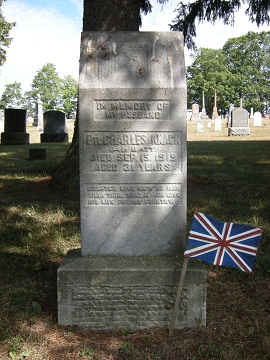
“19860-17 Charles Martin KNACK, 28, carpenter & soldier, Waterloo twp., Preston, s/o Henry KNACK & Mary GALLO (Gello?), married Margetta EVERS, 36, domestic, Preston Ont., res not given, d/o Louis EVERS & Rosannah WELSH, witn: Ernest KNACK of Fishers Mill & Carrie BRYANT of Preston, 1 May 1917 at Preston”
“Charles Martin Knack was born on July 10, 1888 in Hespeler, Ontario, the son of Henry and Mary Knack. He signed his Attestation Paper with the 34th Infantry Battalion in Galt, Ontario, on January 16, 1915, at the age of 26, listing his next-of-kin as his father, Henry Knack of Preston, Ontario, stating he belonged to an Active Militia (A.M.C. in Brandon, Manitoba), that he was not married and that his trade was that of Farmer (Later documented in his Medical History of an Invaild as a Carpenter). [Note: the City of Galt, Towns of Preston and Hespeler, and the hamlet of Blair were amalgamated in 1973, forming the City of Cambridge]. The Battalion was raised and mobilized in Guelph, Ontario under the authority of G.O. 86, July 1, 1915. The Battalion sailed October 23, 1915 with a strength of 41 officers and 1,102 other ranks, including Private Knack, under the command of Lieutenant-Colonel A.J. Oliver. Knack was transferred from the 34th Battalion to the 9th Canadian Reserve Battalion at Shorncliffe on August 27, 1915. He was subsequently transferred to the 18th Battalion on January 19, 1916, being taken on strength in the field on February 4th. His service in the French theatre lasted only two months, when he suffered shrapnel wounds to his right eye and neck on April 6, 1916 at The Battle Of St. Eloi Craters. His medical report stated that “Shrapnel entered (the) right external angular frontal process and tore out the eye ball”, thereby “penetrating (the) cranium” and that he was “operated upon and pieces of bone removed”. One shrapnel bullet remained lodged in his neck, the right eye was destroyed and removed at No. 13 General Hospital at Boulogne, where a glass eye was supplied. Due to the severity of his wounds, his recovery was slow at best. He was transferred to King George Hospital, Stamford Street S.E. on April 23rd and experienced no pain until the 25th, when “severe pain started in (the) head”. On May 3rd, he was transferred to the Ontario Military Hospital at Orpington, Kent, then on May 10th to the Military Convalescent Hospital at Woodcote, Epsom. After a month there, he was transferred to the Canadian Convalescent Hospital at Epsom on June 9th for eight days. By June 17th, he was again transferred, this time to the West Cliffe Canadian Eye and Ear Hosptial at Folkestone, Kent, documented as suffering from a considerable fracture, poor memory and severe nervous shock. The Canadian Expeditionary Force Pensions and Claims Board Report on July 20, 1916 recommended “1. That this man’s discharge be not carried out until he is in receipt of the first payment of the following Pension:, 2. That he be granted a Pension for the period of Six Months under Class I at the rate of 100 per cent, Four Hundred and Eighty Dollars per annum, under the Pay and Allowance Regulations 1914 as amended by P.C. 1334 of June 3rd 1916.” He was discharged on July 11th, seeking additional treatment at the Military Hospital at Shorncliffe (Canadian Casualty Assembly Centre) and later, the Cherryhinton Military Hospital at Cambridge that August, then discharged from Cherryhinton on September 21st. Knack was struck off strength on November 17th at Hastings and proceeded to Canada for discharge. After being treated at hospitals in France and England, he returned to Canada, to Military District No. 1 London, Ontario on November 27th, where he was hospitalized at the London Military Convaescent Hospital. His Medical History of an Invalid, dated November 22, 1917, noted his “loss of right eye and debility” from a from a gun shot wound, with “about 1/2″ of orbital ridge is absent at external canthus of right eye. Satisfactorily fitted with artificial eye. Memory is impaired. Says when de does any light work he gets pain in head.” He was suspected of having Pulmonary Tuberculosis, as his “physical examination shows marked retraction and limitation of movement of right chest”. He had a history of attacks of Pneumonia and Pluerisy at the base area, with his “breath sounds markedly diminished”. The Specialist recommended additional Sanatorium treatment for three months but Knack didn’t agree and it was noted that “His refusal is unreasonable.” Almost three years later, Private Knack, 34th Infantry Battalion “Western Ontario Regiment”, Canadian Infantry (Central Ontario Regiment) died on September 15, 1919 at the age of 31 and is buried in the Cambridge (nee Preston Public) Cemetery, Grave Reference: Lot 15. Blk. A. His Index card notes “Death Due to Service”. The Preston, Ontario Cenotaph, which was dedicated on November 8, 1926, lists the names of Preston soldiers killed in the First and Second World Wars and is inscribed “IN HONOURED MEMORY OF THE MEN OF PRESTON WHO DIED IN THE GREAT WAR AND IN GRATEFUL TRIBUTE TO THOSE WHO SHARED ITS DANGERS.” – See more at: http://www.emedals.com/wwi-pair-st-eloi-craters-dow-c0907#sthash.ciZv2YN7.dpuf”




